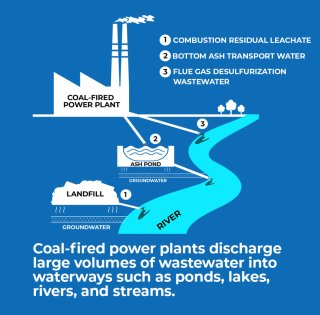Reducing Water Pollution from Power Plants
One of my favorite questions to ask is: What is your favorite body of water? The answer to this question connects people to waterbodies that inspire us. Mine, is the Pacific Ocean.
I have spent endless hours with my children exploring the Pacific coast. This connection is why I do what I do to protect water for future generations.
Your turn. What is your favorite body of water? Is it a lake where you learned to swim? A stream where you turned over rocks to find critters as a kid? A river where you go fishing? Now, imagine if that waterbody was threatened by pollution that could be prevented using technologies that are available and affordable today. That’s where EPA and the Clean Water Act come in.
Understanding the Issue
Steam electric power plants use heat to create steam that turns a turbine and produces electricity. Coal is one fuel that can be used to create heat, others include natural gas, oil, and nuclear fuel. Steam-electric power plants use a lot of water. In 2015, these facilities withdrew 133 billion gallons of water per day—primarily from our rivers, lakes, and estuaries. Coal-fired power plants use water for cooling, generating steam, and for industrial processes like scrubbing air pollutants and transporting coal ash. The industrial process wastewater that is returned to the environment can contain toxic metals and other pollutants that contaminate our vital water sources. Not only does this threaten fish and wildlife, but it can also contribute to serious health risks for people—like cancer in adults and lowered IQs in children. Some of these pollutants, once they are discharged into the environment, can remain there for years.
Making Strides
At EPA, it’s our privilege and responsibility to implement the Clean Water Act, which was passed by Congress 50 years ago with a bold vision that our waters be fishable and swimmable. Under this authority, we follow the science, including innovations in pollution control technology that can get us closer to the clean water future Congress called for.
EPA is committed to following the science and we are proud to propose the strongest limits ever on wastewater discharges from coal fired power plants, using decisions rooted in science.
This is why we proposed to strengthen wastewater discharge standards that apply to coal-fired power plants. EPA’s proposal applies the agency’s longstanding authority under the Clean Water Act to establish discharge standards that reflect the ability of more advanced treatment technologies to remove pollutants.
The Clean Water Act also gives the Environmental Protection Agency flexibility to create workable compliance options for coal-fired power plants that have already invested in water pollution controls or may stop burning coal in the coming years. These flexibilities are also a key feature of EPA’s proposal.
It’s All About Impact
This action will accelerate progress toward less polluting electricity generation that fosters clean water, clean air, healthy lands, and resilient communities. We estimate that the proposed regulation would reduce pollutants discharged through wastewater from coal-fired power plants by approximately 584 million pounds per year.
This action will make the biggest difference in environmental justice communities that so often live, learn, work, and play just downstream from coal-fired power plants. We have known for years that disadvantaged communities are disproportionately hurt by pollution from power plants, and it is no surprise that water quality protections from our proposal would help close this water equity gap.
Our Promise

EPA is consistently working to ensure that all people have clean and safe water while providing regulatory certainty and supporting economic opportunity. Our proposal is one way we are delivering on that promise.
We are also committed to moving forward with transparency and collaboration. As we further develop rules pertaining to our power sector, we are committed to moving forward in a transparent and orderly way to provide industry, states, grid operators, and other stakeholders with regulatory certainty and a clear, long-term planning horizon to support their decision-making.
We are currently requesting public comment on this proposed rule and want to hear from you! You can submit comments in writing (by May 30 2023) and/or tell us your views at one of our public hearings on April 20 and 25, 2023.
This proposed rule would not have been possible without our professional EPA staff. I want to thank them for their tireless dedication to the agency’s mission. They help secure a brighter, cleaner, and healthier future for all.
Comment on the proposed rule or register for a public hearing

About the Author
Radhika Fox
Assistant Administrator
Office of Water
Radhika Fox is the Assistant Administrator for the U.S. Environmental Protection Agency’s Office of Water. The Office of Water works to ensure that drinking water is safe, wastewater is safely returned to the environment, and surface waters are properly managed and protected. Prior to joining EPA, Radhika served as Chief Executive Officer for the U.S. Water Alliance, Director for policy and government affairs for the San Francisco Public Utilities Commission, and the Federal Policy Director at PolicyLink. Radhika has used her 20+ years of experience to address the most salient water issues facing the nation—including climate change, affordability, equity, governance, innovative finance, and the evolution of the One Water movement. Radhika holds a B.A. from Columbia University and a Masters in City and Regional Planning from the University of California at Berkeley where she was a HUD Community Development Fellow.
Editor’s Note: The views expressed here are intended to explain EPA policy. They do not change anyone’s rights or obligations. You may share this article. However, please do not change the title or the content, or remove EPA’s identity as the author. If you do make substantive changes, please do not attribute the edited title or content to EPA or the author.
EPA’s official web site is www.epa.gov. Some links on this page may redirect users from the EPA website to specific content on a non-EPA, third-party site. In doing so, EPA is directing you only to the specific content referenced at the time of publication, not to any other content that may appear on the same webpage or elsewhere on the third-party site, or be added at a later date.
EPA is providing this link for informational purposes only. EPA cannot attest to the accuracy of non-EPA information provided by any third-party sites or any other linked site. EPA does not endorse any non-government websites, companies, internet applications or any policies or information expressed therein.

